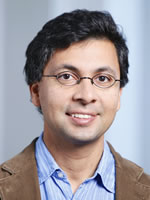First Meeting
- Time
- Mar. 7, 2015
- Venue
- Room 77201 at #78 courtyard, Beijing International Center for Mathematical Research
- Principal Speaker
- Rahul Pandharipande (ETH, Zurich)
- Other Speakers
-
Bohan Fang (Peking University)
Xiaowen Hu (Peking University)
Si Li (Tsinghua University)
Si-Qi Liu (Tsinghua University)
Xin Wang (Peking University)

Schedule
- 9:00-9:30
- Coffee and Tea
- 9:30-10:30
- Rahul Pandharipande (ETH, Zurich)
Cohomology of the moduli space of curves - 10:30-11:00
- Coffee and Tea
- 11:00-12:00
- Bohan Fang (Beijing University)
BKMP conjecture for toric Calabi-Yau 3-folds - 12:00-13:00
- Xiaowen Hu (Beijing University)
Computing the quantum cohomology of primitive classes - 13:00-15:00
- Lunch
- 15:00-16:00
- Si Li (Tsinghua University)
Mirror Theorem between Landau-Ginzburg models - 16:00-17:00
- Xin Wang (Beijing University)
Conditions for the vanishing of the genus-2 G-function - 17:00-17:30
- Coffee and Tea
- 17:30-18:30
- Si-Qi Liu (Tsinghua University)
Analyticity of Total descendant potentials - 19:00
- Dinner
Abstracts
Rahul Pandharipande
Title: Cohomology of the moduli space of curves
Abstract: The moduli space of curves carries tautological cohomology classes. I will discuss the study of relations amongst these classes starting with ideas of Mumford in 1980s. The subject advanced in the 1990s with conjectures of Faber and Faber-Zagier. I will explain the current state of affairs based on Pixton's conjectures related to cohomological field theories. The talk represents joint work with A. Pixton and D. Zvonkine.
Bohan Fang
Title: BKMP conjecture for toric Calabi-Yau 3-folds
Abstract: Eynard-Orantin's recursion is a powerful and effective method to compute higher genus invariants for a class of B-model topological strings. It can be used to predict A-model all genus open-closed Gromov-Witten invariants of any semi-projective toric CY 3-(orbi)fold, a.k.a. the BKMP remodeling conjecture. I will describe this conjecture, and outline a proof based on the joint work with Melissa Liu and Zhengyu Zong.
Xiaowen Hu
Title: Computing the quantum cohomology of primitive classes
Abstract: For smooth complete intersections in the projective spaces, we make use of the deformation invariance and $S_n$-symmetry of the Gromov-Witten invariants and results in classical invariant theory to study the symmetric
reduction of the WDVV equation by the monodromy groups. We discuss to what extent the quantum cohomology involving primitive cohomology classes can be determined. In particular, we obtain a reconstruction theorem for cubic hypersurfaces and odd dimensional complete intersection of two quadrics.
Si Li
Title: Mirror Theorem between Landau-Ginzburg models.
Abstract: In this talk, I will prove the Landau-Ginzburg mirror symmetry conjecture for general quasi-homogeneous singularities, i.e., the FJRW theory (LG A-model) of such polynomial is equivalent to the Saito-Givental theory (LG B-model) of the mirror
polynomial. This is joint work with Weiqiang He, Rachel Webb and Yefeng Shen.
Xin Wang
Title: Conditions for the vanishing of the genus-2 G-function
Abstract: In this talk we give some sufficient conditions for the vanishing of the genus-2 G-function, which was introduced by B. Dubrovin, S. Liu and Y. Zhang . As a corollary we prove their conjecture for the vanishing of the genus-2 G-function for ADE singularities and P^{1} orbifolds of ADE type.
Si-Qi Liu
Title: Analyticity of Total descendant potentials
Abstract: We define the notion of analyticity of funtions on the big phase space, and prove that the total descendant potention of a semisimple Frobenius manifold is analytic if its potential and G-function is analytic. Our result implies the analyticity of total ancestor potentials in singularity theory, which is proved by Milanov recently. By using the analyticity, we also prove the vanishing of the genus two G-function for simple singularities or $\mathbb{P}^1$-orbifolds with positive Euler characteristics, which is conjectured in our previous work.